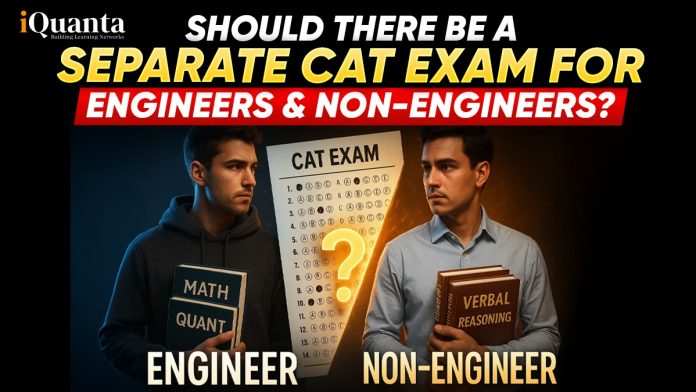The Common Admission Test (CAT) is considered the golden opportunity to enter into Indian Institutes of Management (IIMs) and other top B-schools. But over the last decade, a question has consistently emerged in everyone’s mind: Should there be separate CAT exams or evaluation processes for engineers and non-engineers?
This question divides people having different mindsets. On one side are those who argue that the current format gives an unfair advantage to engineering students; on the other side are those who believe that management education should include quantitative tests. In this blog, we’ll understand this debate in detail along with the structure of the CAT exam, what both sides of the argument say, and what balanced approach can be put forward.
Join this free WhatsApp group to get the latest information about CAT exam along with the strategies by CAT experts

Current CAT Structure
The Common Admission Test (CAT) is a computer-based exam which consists of three sections:
- Verbal Ability and Reading Comprehension (VARC): 24 Questions
- Data Interpretation and Logical Reasoning (DILR): 22 Questions
- Quantitative Ability (QA): 22 Questions
Each of the sections of the CAT exam carries equal weightage. QA and LRDI are skill areas where engineers perform better than non-engineers because of their academic background and constant exposure to math subjects. Non-engineers particularly study commerce, arts, or law and many a time struggle with QA and LRDI. And the reason for non-engineers struggling with these sections is because their UG course does not demand advanced problem-solving or higher mathematics. This is the result of the argument for a separate evaluation or separate CAT exam pattern.
In Favour of Separate CAT Exams
Let’s know why some people believe that a separate CAT exam for engineers and non-engineers would make the process fairer.
- Leveling the Playing Field
The CAT exam’s QA section includes topics like probability, permutation & combination, and algebra—concepts that engineers are more comfortable with. A non-engineer student might feel stressful while learning the basics of these topics within short span of preparation time. A separate exam could balance the impact, giving equal weightage to areas where non-engineers might excel, such as critical thinking, verbal ability, case analysis, or decision-making.
- Encouraging Academic Diversity in IIM Classrooms
During IIM admissions, diversity always plays an important role. Over the years, many IIMs have introduced academic diversity weighting during the selection process to bring more numbers of non-engineers into classrooms. But critics argue that this is not a solution; if the exam itself remains tilted towards QA, the diversity weighting cannot fully correct the imbalance. Having separate CAT exams with slightly more emphasis on logical reasoning, general knowledge, or business awareness could naturally make classrooms more diverse, without any additional bonus academic weightage.
- Reflection of Managerial Skills
The management program is not just about mathematics; rather, it involves leadership, communication, and decision-making, the qualities that are not directly evaluated by CAT’s current exam pattern. A separate exam for non-engineers could focus more on situation-based judgement, case studies, and critical thinking, which might create a more holistic selection process and also identify future managers rather than just strong problem solvers.
- Less Psychological Pressure on Non-Engineers
Many non-engineer aspirants feel demotivated during preparation because of the only perception that “CAT is for engineers.” A separate exam could encourage more aspirants from diverse backgrounds to attempt CAT, knowing that the playing field is equal and their strengths will be fairly evaluated.
In Against of Separate CAT Exams
Now let’s look at the opposite side of the argument and understand why many educators, B-school administrators, and even aspirants argue against separate CAT exams.
- Management is Number-Driven
Managers deal with data, budget, analytics, and financial decisions. A candidate’s ability to handle numbers is crucial for success while pursuing MBA course and also in corporate life. If the QA and LRDI section are challenging, that is by design and to filter the students who are good with data-driven decision-making. Diluting the exam compromise the academic rigour that many top B-school are looking for or known for.
- Fairness in Comparison and Selection
CAT is a competitive exam, and its percentile-based scoring results in comparison between a very large applicant pool. If there are two separate exams, comparing scores and percentiles across these groups would become complicated and will involves hassles. How would IIMs ensure thata 99 percentiler from a non-engineer background will be equal in skill level to a 99 percentiler from an engineer background? The lack of standardization could lead to disputes, confusion, and allegations of being bias.
- Involves Additional Cost Challenges
Conducting two separate exams involves extra cost, i.e., the cost of separate question papers, managing the normalisation process across slots for two different sets of candidates, and also ensuring that there is no question paper leak or unfair advantage. This would significantly increase the complexity of an already existing massive exam which expects 3 lakh-plus applicants every year. The cost and resources required may not justify the outcome of the separate exams for engineers and non-engineers.
- Aspirants Can Overcome the Gap
There are many examples of non-engineers who have already proved that with the right preparation one can easily score 99+ percentiles and make it to top IIMs, which means that success is possible regardless of academic background. Many coaching institutes offer tailored program for non-engineers that can allow them to easily catch up and overcome the gap.
Possible Midway of the Debate
Instead of separate CAT exams, other changes could be made within the existing system to address this diversity concern while maintaining academic standards.
- Balance in QA Section: Making the QA section more approachable for non-engineers, the exam paper should not disproportionately feature high-algebra and geometry questions.
- Redistribution of Weightage: The weightage of VARC and LRDI sections should be increased slightly, which means evaluating the reasoning and comprehension skills of students across all streams like commerce, humanities, law, or engineering.
- Sectional Normalization: A more advanced sectional normalization technique could be adopted while calculating percentiles.
- Post-Exam Diversity Filters: The system should continue with academic diversity weightage but the process should be made more transparent and consistent across IIMs.
Conclusion
The question—Should there be separate CAT exams for engineers and non-engineers?—is not easy to answer. If you value a level playing field, you might support a separate exam or at least a structured question paper that reduces the quant-heavy bias. And, if you agree that the current system is already working well and is giving high-quality managers every year, you will support the process of standardisation and academic rigour.
In the end, the common goal of the CAT exam and IIMs is to produce the best future business leaders, not just the best mathematicians. Should CAT evolve to include separate exams or papers, or should aspirants simply work harder to bridge the gap? What do you think? The future of MBA admissions in India might just depend on how this debate plays out.
Join iQuanta CAT Crash Course 2025





